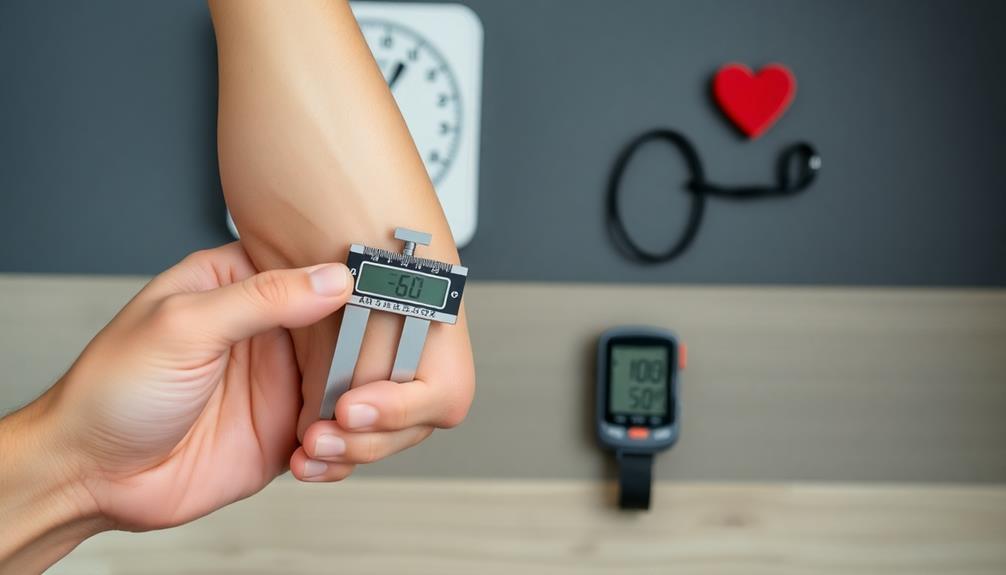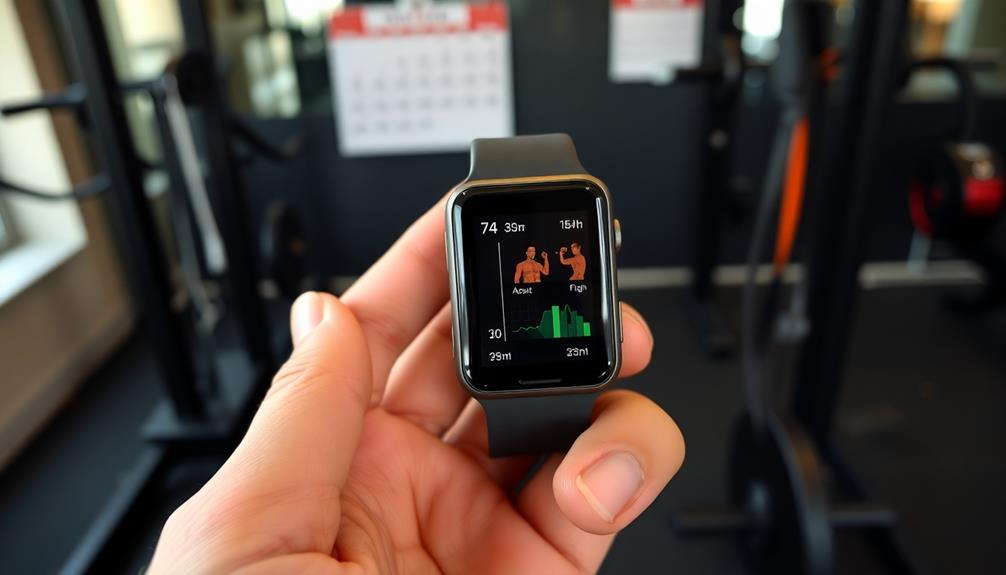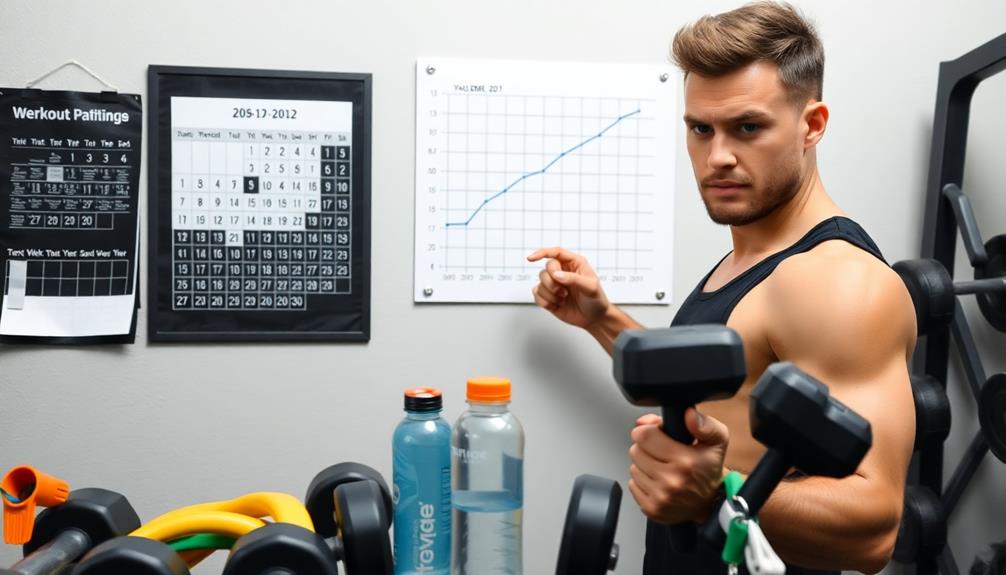To create the perfect cutting workout program, start by defining clear goals and evaluating your current fitness level. Calculate your caloric needs for a deficit, prioritizing protein intake. Develop a resistance training plan targeting multiple muscle groups, incorporating progressive overload. Combine HIIT and steady-state cardio for effective fat loss. Enhance recovery with quality sleep and stress management. Monitor your progress regularly and adjust your plan as necessary. Supplement wisely with protein powder and creatine, but focus on whole foods. Stay consistent and motivated by celebrating small victories and maintaining a support system. The following steps will guide you through creating a thorough cutting program.
Core Insight
- Design a resistance training plan targeting multiple muscle groups to preserve lean mass during cutting.
- Incorporate a mix of HIIT and steady-state cardio for optimal fat loss and metabolic boost.
- Calculate and maintain a calorie deficit based on BMR and TDEE while prioritizing protein intake.
- Track progress regularly through measurements, photos, and strength indicators, adjusting the program as needed.
- Optimize recovery with quality sleep, stress management, and strategic use of rest days.
Define Your Cutting Goals

Before starting your cutting program, set clear goals. What do you want to achieve? Do you want to lose body fat, get more muscle definition, or get ready for a competition? Aim to lose 0.5-1% of your body weight each week. Think about how much fat you want to lose. You might consider using appetite suppressants to help with cravings, but always talk to your doctor first.
Decide how long you want to cut for. This could be 4-16 weeks, depending on your goals and starting point. Longer cutting periods may be needed to lose a lot of fat while keeping muscle. Once you have your goals and timeline set, you can make a workout and nutrition plan that fits them. Having clear goals will keep you motivated and help you track your progress.
Assess Your Current Fitness Level

To design a cutting program that works, start by figuring out your current fitness level. Take various measurements and do some tests. Weigh yourself and calculate your body fat percentage. Measure key areas like your waist, chest, and arms. Test your strength on main lifts and check your cardio endurance. Think about how you feel physically and mentally during workouts. Do you have energy or feel tired? Do you bounce back quickly between gym sessions? Are you getting good sleep and keeping stress in check? How's your general mood and motivation?
This information gives you a starting point to set achievable goals. It also helps you decide the intensity and volume of your cutting plan. Keep in mind, everyone begins at a different fitness level. Don't worry about comparing yourself to others. Just focus on making progress and tweaking your program when needed based on regular check-ins and measurements.
Calculate Your Caloric Needs

Determining your daily calorie needs is key for successful weight loss. First, calculate your Basal Metabolic Rate (BMR) using the Harris-Benedict equation, which factors in age, height, weight, and gender. Then, multiply your BMR by an activity factor to find your Total Daily Energy Expenditure (TDEE):
1.2 – Sedentary (little to no exercise)
1.375 – Lightly active (light exercise 1-3 days per week)
1.55 – Moderately active (moderate exercise 3-5 days per week)
1.725 – Very active (hard exercise 6-7 days per week)
To lose weight, subtract 10-20% from your TDEE. This creates a calorie deficit that promotes fat loss while maintaining muscle. As you progress, reassess your calorie intake and adjust as needed. Consider taking supplements that support brain health and focus during your weight loss journey, especially when eating fewer calories.
Design Your Resistance Training Plan

Four essential elements make up a good resistance training plan: the exercises you choose, how often you work out, the number of sets and reps, and gradually increasing the difficulty. Pick exercises that work several muscles at once, like squats, deadlifts, and bench presses. Try to do 3-4 resistance training workouts each week, with enough rest days in between. Change the number of sets and reps to match your cutting goals. Think about using resistance bands in your workouts for variety and to work your muscles from different angles. They're handy for home workouts or when you're traveling.
To stay motivated and see your progress, try:
- Writing down your workouts
- Making realistic short-term goals
- Switching up your exercises, so you don't get bored
- Celebrating your achievements, no matter how small
Don't forget to make your workouts harder over time by slowly adding more weight, reps, or sets. This keeps your muscles challenged and prevents you from hitting a plateau. Be flexible with your plan, pay attention to your body, and make changes based on your progress and recovery.
Incorporate Effective Cardio Strategies

Effective cardio is key for a successful cutting workout. Mix high-intensity interval training (HIIT) and steady-state cardio to burn fat and keep muscle. HIIT and the right supplements can boost your results.
For HIIT, try sprints, burpees, or jump rope. These short, intense exercises rev up your metabolism, helping you burn calories post-workout. Aim for 2-3 HIIT sessions a week, 15-20 minutes each.
Steady-state cardio includes jogging, cycling, or swimming. These longer, medium-intensity workouts improve heart health and burn calories. Do 2-3 sessions a week, 30-45 minutes each.
Plan Your Nutrition Strategy

To cut successfully, you need to pay close attention to your diet. It's just as important as working out. The goal is to eat fewer calories than you burn while still getting enough protein to keep your muscles strong. First, figure out how many calories you need each day. Then, eat 10-20% less than that. Choose foods like lean meats, whole grains, and healthy fats. If you're on a keto diet, supplements can help you stay energized and burn fat. They work well with your overall nutrition plan.
Some tips to stick with your diet:
- Make your meals ahead of time
- Write down what you eat in a food journal
- Drink lots of water to stay hydrated
- Treat yourself once in a while so you don't get burned out
Optimize Recovery and Rest

Sleep is crucial for recovery during a cutting program. Get 7-9 hours of quality sleep every night by:
- Sticking to a regular sleep schedule
- Keeping your bedroom cool, dark, and quiet
- Using magnesium sprays before bed to relax muscles
On rest days, do light activities like walking or yoga to improve blood flow and reduce soreness without overworking your body.
Managing stress is key. Try meditation or deep breathing to lower stress levels, which can slow down recovery and progress.
Stay hydrated by drinking water throughout the day. This supports muscle recovery and overall health.
Track Progress and Adjust

Track your progress regularly to see how well your cutting program is working. This lets you make changes if needed. Write down your workouts, weight, and measurements in a journal. Every 2-4 weeks, take photos to see changes in your body. Keto supplements may help you burn more fat and keep muscle.
Stay motivated by remembering:
- You're doing this for your health
- Small wins add up to big results
- Stick with it for long-term success
- Your effort will be worth it
Look at your progress often. If you aren't getting the results you want, change things up. Try eating fewer calories, doing more cardio, or changing your weight training. Be patient, since everyone is different. By tracking your progress and making changes, you'll get the most out of your cutting program and reach your fitness goals.
Supplement Wisely

Supplements can support your cutting goals, but they aren't a magic fix. Zero in on the basics: protein powder helps you hit your daily protein target, and creatine may help maintain muscle during a calorie deficit. A multivitamin can fill in any nutrition gaps. If you're doing keto, certain supplements might give you an extra edge by helping you stay in ketosis and burn fat.
Pre-workout supplements can give you a boost for tough workouts, but watch out for too much caffeine. BCAAs could help protect your muscles, but they may not be necessary if you're eating enough protein.
Always choose whole foods over supplements when you can. Do your research and talk to a doctor before starting any new supplements. Remember, supplements should be an addition to a solid diet and exercise plan, not a replacement. Watch out for products that promise unbelievable results, and stick with trusted brands.
Stay Consistent and Motivated

Consistency and motivation are key to a successful cutting program. To stay on track, you need discipline and inspiration. Set realistic goals and track your progress, celebrating small wins. Join fitness communities or find a workout buddy to create a support system. Using cold therapy compression wraps during recovery can help with muscle soreness and inflammation, keeping you motivated and consistent.
Boost your motivation with these tips:
- Picture your end goal and how achieving it will feel
- Make a motivating workout playlist
- Treat yourself when you reach milestones
- Change up your routine to avoid boredom
Frequently Asked Questions
How Long Should a Typical Cutting Phase Last?
Your cutting phase typically lasts 8-12 weeks. You'll want to adjust based on your starting body fat and goals. Don't rush it; slow, steady progress guarantees you maintain muscle mass while shedding fat. Monitor your progress weekly.
Can I Build Muscle While on a Cutting Program?
You can build muscle while cutting, but it's challenging. Focus on maintaining a slight calorie deficit, consuming adequate protein, and engaging in resistance training. You'll likely see slower muscle gains compared to bulking, but it's possible with consistency.
What's the Ideal Body Fat Percentage to Start a Cut?
You'll want to start your cut when you're between 15-20% body fat for men or 22-27% for women. You've got enough fat to lose while maintaining muscle. Don't start too lean, or you'll risk losing muscle mass.
How Do Hormones Affect the Cutting Process?
Your hormones greatly impact your cutting process. They'll influence fat loss, muscle retention, and energy levels. You'll need to manage stress, optimize sleep, and balance your diet to keep hormones in check during your cut.
Is It Necessary to Cycle Between Bulking and Cutting Phases?
You don't always need to cycle between bulking and cutting. It depends on your goals. If you're happy with your current size, you can maintain. However, cycling can help you achieve specific body composition changes more effectively.

